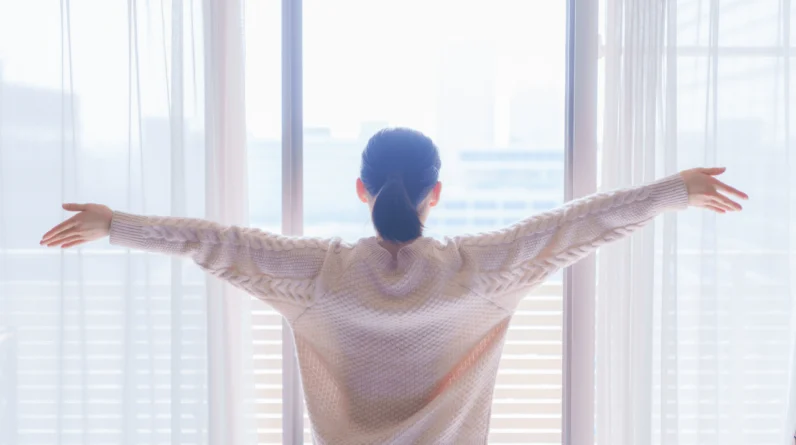
Do we all think the same?
How do we think differently?
Well, surprisingly, there are many differences between people (more than most of us would think—pun intended).
Now, if I asked you to visualize a green dragon with orange scales blowing fire and emerging from a dark cave, you’d probably be able to do this fairly easily. Many akin this visualization ability to breathing; it’s inherent. It’s innate. It’s not something we necessarily “try” to do. But, surprisingly, not all of us can do this.
About 2-4% of the population has aphantasia.
In other words, 2-4% of the population can’t visualize images in their mind.
- So, can they practice visualization and meditation?
- How does aphantasia impact these relaxation and self-care strategies?
In this article, we explore this characteristic (yup, it’s a characteristic—not a condition) and what it means for these types of practices.
What Does Someone With Aphantasia See?
Put simply, an individual with aphantasia is technically unable to visualize anything in their head.
For these individuals, the concept of a “mind’s eye” is fundamentally different from those who can easily conjure mental images.
While most people can close their eyes and visualize a familiar face, a beautiful sunset, or a memorable scene from their past, those with aphantasia see only darkness or nothing at all. This lack of visual imagination is sometimes referred to as “mind-blindness,” as they cannot voluntarily create or manipulate mental pictures in their thoughts.
However, it’s important to note that aphantasia exists on a spectrum—and the extent of mind-blindness can vary from person to person. Some individuals with aphantasia may experience brief, fleeting flashes of imagery, while others report a complete absence of visual imagination.
Additionally, aphantasia may not be limited to visual imagery; it can also affect other sensory domains, such as the ability to imagine sounds, tastes, smells, or tactile sensations. For example, someone with aphantasia might struggle to imagine the sound of a loved one’s voice or the aroma of their favorite dish.
Despite the lack of mental imagery, people with aphantasia can still think, reason, and function normally in their daily lives. They often rely on other cognitive strategies, such as verbal descriptions or abstract concepts, to process information and memories.
As previously mentioned, aphantasia is not considered a disorder or disability but rather a variation in human experience that does not typically impair learning, memory, or other cognitive functions.
However, individuals with aphantasia may face challenges in certain tasks that heavily depend on visualization, such as reading fiction, following descriptive narratives, or engaging in creative pursuits that involve visual imagination, which leads us right into the next section of this article…
Visualization, Meditation, & Aphantasia: Is It Possible to Meditate With Aphantasia?
Visualization is a common technique used in meditation practices, where individuals are encouraged to create mental images or scenes to promote relaxation, reduce stress, or gain insights.
However, for people with aphantasia, the inability to voluntarily generate mental imagery can raise questions about their ability to engage in visualization-based meditation exercises. This has led to discussions about whether it is possible to meditate effectively with aphantasia.
While visualization may be a significant component of some meditation practices, it is not the only way to meditate. People with aphantasia can still engage in and benefit from meditation by focusing on other sensory experiences, such as bodily sensations, sounds, or the breath.
Mindfulness meditation, for example, emphasizes bringing attention to the present moment and observing thoughts and sensations without judgment. This practice can be beneficial for individuals with aphantasia, as it does not rely on visual imagery.
Moreover, some people with aphantasia report being able to experience a sense of inner peace, calm, or even spaciousness during meditation despite their inability to create mental images. They may use other cognitive strategies, such as verbal cues, to guide their meditation practice. For instance, instead of visualizing a peaceful scene, they might mentally repeat a calming phrase or mantra.
It is important to recognize that the experience of meditation is highly individual and can vary significantly from person to person, regardless of whether they have aphantasia or not. While those with aphantasia may not be able to engage in visualization-based meditation practices in the same way as those with visual imagery, they can still adapt and find alternative techniques that work for them.
Related Article: Find Your Zen: 25 Daily Mantras to Cultivate a Positive Mindset
Meditation Strategies for Aphantasia
Here are some pointers to help those with aphantasia take advantage of meditative techniques, despite the inability to visualize:
- Focus on your breath: Pay attention to the sensations of breathing, such as the feeling of air entering and leaving the nostrils or the rise and fall of the chest.
- Perform body scan meditation: Systematically bring attention to different parts of the body, observing any sensations, tension, or relaxation without judgment.
- Practice mindful listening: Concentrate on the sounds in the environment, such as birds chirping, leaves rustling, or the hum of appliances, to anchor the mind in the present moment.
- Use mantras: Silently repeat a word, phrase, or sound to create a focal point for attention and promote a sense of calm.
- Incorporate tactile sensations: Focus on the sense of touch, such as the feeling of clothing against the skin, the texture of a meditation cushion, or the sensation of hands resting on the lap.
- Try counting: Silently count the breaths, thoughts, or other chosen objects of attention to help maintain focus and concentration.
- Perform a guided meditation with verbal cues: Listen to guided meditations that use descriptive language and verbal prompts to create a sense of relaxation, presence, and inner calm.
Related Article: Unlock Your Zen: The Magic of Progressive Muscle Relaxation
Embracing Meditation Without Mental Imagery
While aphantasia may present unique challenges for individuals seeking to engage in visualization-based meditation practices, it is essential to recognize that meditation is a highly personal experience that can be adapted to suit individual needs and cognitive styles.
By focusing on alternative sensory experiences, such as the breath, body sensations, sounds, or verbal cues, individuals with aphantasia can still cultivate mindfulness, inner peace, and the many benefits associated with regular meditation practice.
The key is to approach meditation with an open mind, experiment with different techniques, and find the strategies that resonate most strongly with one’s own experience.
Ultimately, the power of meditation lies not in the ability to create mental images but in the capacity to be fully present, accepting, and compassionate towards oneself and others.
Read Next: Your Ultimate Mindfulness Guide: Become More Happy and Less Stressed
Photo by cottonbro studio







